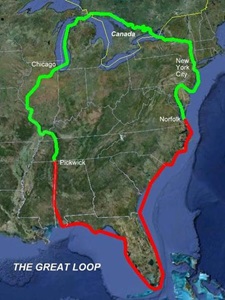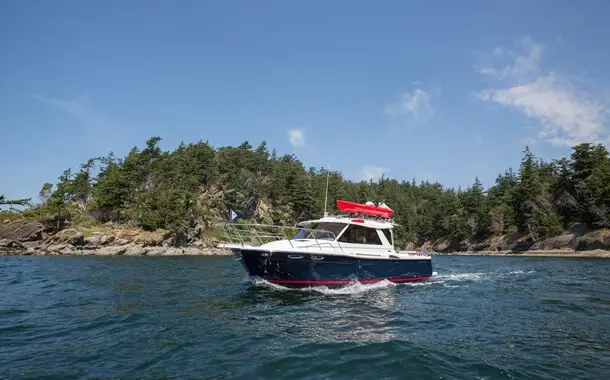How Much Does it Cost to Do the Great Loop?
Last Updated on January 5, 2024
Written by CPA Alec Pow | Content Reviewed by ![]() CFA Alexander Popinker
CFA Alexander Popinker
The Great Loop voyage has been called the “trip of a lifetime”. Some people say it allows you to intimately experience the diversity of the eastern United States and Canada. But before going on such, it’s very important to understand the typical costs and plan your Loop budget wisely.
In this guide, I’ll break down the costs of completing the Great Loop. We’ll cover everything from fuel costs, marina fees, and boat repairs to provisioning and entertainment. Read on to learn what it takes to budget for this quintessential boating adventure!
How Much Does it Cost to Do the Great Loop?
The total cost to do the Great Loop Adventure ranges from around $25,000 for frugal smaller boats anchoring frequently up to $50,000+ for luxurious big boat trips with expensive provisioning and primarily marinas. Most cruises cost $30,000 to $45,000. Here’s a detailed breakdown:
Fuel Costs – $8,000 to $25,000
For most Loopers, diesel fuel ranks as the single biggest expense, often amounting to 30-40% of costs. Mid-speed trawlers and cruisers burning 5-25 gallons per hour at $3-5/gallon spend:
- $8,000-$15,000 for 30-45′ efficient cruisers.
- $12,000-$20,000 for larger trawlers and yachts with higher consumption.
- $20,000+ for fast 50’+ cruisers with 200+ gallon tanks.
Reducing speed, going fuel efficient boats, and choosing inexpensive fuel docks all help reduce costs. Fuel surcharges at some marinas can also drive up spending.
Slip Fees and Marina Costs – $5,000 to $15,000+
To complete the Loop, you’ll spend nights at marinas unless anchoring out each night. Typical costs:
- $5,000-7,500 for 40% marina nights, 60% anchoring
- $10,000 to $15,000+ for 75% or more marina nights
Marina fees often run $50-100+ per night which might not seem like a lot, but adds up pretty quickly. Off-season savings, loyalty programs, booking ahead, and hunting for deals help cut these costs.
Boat Maintenance and Repairs – $3,000 to $10,000
With thousands of open water miles and endless engine hours, repairs and maintenance are expected. Budget for:
- $500-1,000 monthly for minor tune-ups, oil changes, pump-outs.
- $1,000+ for each haul-out, bottom job, etc.
- $2,000-$5,000+ for major issues like electronics failures or engine repairs.
Avoiding deferred maintenance before the Loop, bringing spare parts, and having insurance all help limit surprises.
Provisioning – $6,000 to $15,000
Groceries and dining out rank high on most Great Loop budgets. Depending on your style, plan on:
- $500-$1,000 per month at marina stores
- $750-$1,500 monthly for extensive provisioning
- Hundreds more monthly on restaurants and entertainment
Anchoring out and finding supermarkets helps reduce costs considerably.
Insurance, Comfort Necessities, & More – $5,000+
Other cruising costs typically add up to many thousands:
- Boat insurance premium increase – Often doubles.
- Comfort items like oil changes, pump-outs, and laundry.
- Sightseeing, transportation, and entertainment
- Shore power, dockage, and park fees
- Gear, electronics, canvas, parts, boat upgrades
You might also like our articles about the costs of transporting, repairing, or storing a boat.
These “miscellaneous” costs often total $5,000 to $10,000+.
Monthly and Seasonal Cost Ranges
- $3,500-$5,500 per month is common, covering basics.
- $6,000-$10,000+ monthly for greater comforts and expenses.
- Off-season savings on dockage, but fewer anchored out options.
- Budget more for shoulder and peak seasons with higher marina demand.
According to the Scho & Jo website, the monthly expenses to enjoy the Great Loop experience on a budget can range from $2,000 to $5,000, depending on the type of boat, the route, and the lifestyle. The website also provides a breakdown of expenses, including fuel, food, marinas, and other costs.
The website Seattle Yachts provides a guide to the cost of doing the Great Loop, which can vary depending on factors such as the type of boat, the length of the trip, and the specific expenses. The website suggests that joining the America’s Great Loop Cruisers Association (AGLCA) is a good investment, as it provides access to resources and discounts.
Technomadia also offers a breakdown of the costs of doing the Great Loop for one year, which totaled $38,000 in 2018. The website also goes over the challenges and rewards of doing the Great Loop.
Factors That Influence Your Great Loop Cruising Costs
Several factors impact how much you’ll spend to cruise the Great Loop waterway:
Boat Size and Type
The size, type, and fuel efficiency of your vessel greatly affect costs. Larger, heavier boats with less efficient engines burn much more fuel, which is often the biggest Loop expense.
- 30-45 feet – $8k-$15k in fuel for trawler yachts and cruisers
- 45-65 feet – $15k-$25k+ for larger, heavier cruisers and motor yachts
Lighter displacement trawlers and boats with efficient diesel engines use far less fuel. Cruising in a well-maintained boat suited for long voyages also reduces repair costs.
Cruising Speed and Daily Fuel Consumption
Your cruising speed and resulting fuel usage per hour impacts fuel costs exponentially. Reducing from 8 to 6 knots could decrease fuel burn by 25-50% or more. Most Loopers cruise at 6-8 knots.
Marina Nights vs. Anchoring Out
Dockage fees from staying at marinas along the Loop often range from $50 to over $100 per night. Marina nights quickly add up, so anchoring out when possible saves substantially – just $0-15 per night.
Maintenance Needs and Repairs
No boat escapes 6,000+ miles of cruising without some maintenance and repairs. Anything from minor tune-ups to major mechanical issues and hull or electrical problems can arise, costing $500 to many thousands. Budgeting extra for repairs reduces headaches.
Boating Experience and Confidence
Newer boaters unfamiliar with open water passages or veteran Loopers will likely have different costs. Those less comfortable anchoring out or handling locks and bridges may opt for more marinas and help. Experience brings confidence that can reduce expenses.
Cruising Season and Itinerary
Cruising during peak season when more facilities are open, but rafting up may be needed at crowded marinas. The route chosen also impacts costs, as some areas have far higher marina rates. Planning when and where to cruise helps control spending.
Why Careful Budgeting Matters for Great Loop Cruises
Like any extended cruise spanning months and thousands of miles, completing the Great Loop requires thoughtful preparation and budgeting. Being realistic about the expenses allows you to:
- Determine if your current boat and finances can comfortably handle the journey
- Make adjustments like purchasing a more efficient boat or limiting time in high-cost areas
- Save enough in advance to afford the trip without financial strain
- Gain peace of mind knowing you’ve budgeted wisely for this bucket list adventure
While costs vary based on your cruising style, boat, and preferences, having guidelines for typical expenses helps immensely with planning. By researching what other Loopers spend on fuel, slips, repairs, and more, you can cruise the Loop without busting your budget.
How to Plan and Reduce Your Great Loop Expenses
 While completing the Great Loop certainly isn’t cheap, many veteran cruisers complete it for less than $40,000 through careful planning:
While completing the Great Loop certainly isn’t cheap, many veteran cruisers complete it for less than $40,000 through careful planning:
Pick an Efficient, Comfortable Boat – Choosing the right boat for your needs dramatically reduces costs and headaches. Consider fuel efficiency, range, reliability, docking ease, and comfort.
Run an Efficient Cruising Speed – Monitoring your speed and fuel burn allows you to maximize range. Reducing just 1-2 knots can increase miles per gallon by 25% or more.
Anchor Out Whenever Possible – Skipping marinas for free or low-cost anchorages saves tremendously on dockage fees – often $50-100+ per night!
Stick to Your Planned Itinerary – Limit extra travel and “detours” which add costs quickly. Stick close to the ideal route.
Join Discount Programs Like Boaters Landings – Look into loyalty programs that provide discounts on fuel or slips for frequent boaters. Every bit helps!
Use Tools Like ActiveCaptain to Research Costs – Check marina rates, anchorages, fuel prices, and Loopers’ reviews of stops. Planning helps limit surprises.
Talk to Other Loopers – Veterans are happy to share tips on provisioning, routes, saving money, and what to budget for. Their insights are invaluable.
Additional Resources for Planning Your Great Loop Budget
To further research costs, check out:
- The Great Loop Cruisers’ Association – Tips from veteran loopers
- Fuel cost calculators – Estimate your total fuel needs
- ActiveCaptain – Marina and anchorage reviews and rates
- Provisioning guides – Groceries and expenses along the Loop
- Cruiser forums – Budgeting discussions from other cruisers
Final Words
With careful upfront planning and a good buffer for incidentals, you can cruise the Great Loop without breaking the bank. Here’s wishing you happy Looping and calm winds ahead! Let me know if you need any clarification or have additional budgeting questions.


Leave a Reply
Want to join the discussion?Feel free to contribute!